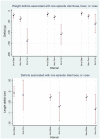Comparative effects of vivax malaria, fever and diarrhoea on child growth
- PMID: 22258823
- PMCID: PMC3324452
- DOI: 10.1093/ije/dyr190
Comparative effects of vivax malaria, fever and diarrhoea on child growth
Abstract
Background: The adverse impact of Plasmodium vivax on child health beyond acute febrile illness is poorly studied. The effect of vivax malaria on child growth was evaluated and compared with diarrhoeal disease and non-specific fever.
Methods: Using data from a 43-month longitudinal cohort of children 0-72 months of age (n = 442) in the Peruvian Amazon, ponderal and linear growth velocities over 2-, 4- and 6-month periods were examined using longitudinal models and related to the incidence of disease during the same period.
Results: An episode of vivax malaria led to 138.6 g (95% confidence interval (CI) 81.9-195.4), 108.6 g (62.8-153.2) and 61 g (20.9-101.1) less weight gain over 2-, 4- and 6-month intervals, respectively. These deficits were larger than both diarrhoea (21.9, 17.2 and 13.8 g less weight gain, respectively) and fever (39.0, 30.3 and 25.6 g less weight gain, respectively). An incident episode of vivax also led to 0.070 cm (0.004-0.137) and 0.083 cm (0.015-0.151) less linear growth over 4 and 6 months, respectively, which were also larger than deficits from diarrhoea (0.029 and 0.028 cm, respectively) and fever (not associated with linear growth deficits). Despite the larger effect of P. vivax incident episodes on growth of a particular child, diarrhoeal disease had a larger cumulative impact on growth deficits as diarrhoeal incidence rates in this community are >10-fold higher than vivax malaria.
Conclusions: Disease control measures for vivax malaria and diarrhoeal disease have the potential to improve the growth of children in endemic areas.
Figures



References
-
- Black RE, Allen LH, Bhutta ZA, et al. Maternal and child undernutrition: global and regional exposures and health consequences. Lancet. 2008;371:243–60. - PubMed
-
- Grantham-McGregor S. A review of studies of the effect of severe malnutrition on mental development. J Nutr. 1995;125:2233S–38S. - PubMed
-
- Haas JD, Martinez EJ, Murdoch S, Conlisk E, Rivera JA, Martorell R. Nutritional supplementation during the preschool years and physical work capacity in adolescent and young adult Guatemalans. J Nutr. 1995;125:1078S–89S. - PubMed
-
- Victora CG, de Onis M, Hallal PC, Blossner M, Shrimpton R. Worldwide timing of growth faltering: revisiting implications for interventions. Pediatrics. 2010;125:e473–80. - PubMed
Publication types
MeSH terms
Grants and funding
LinkOut - more resources
Full Text Sources
Medical

